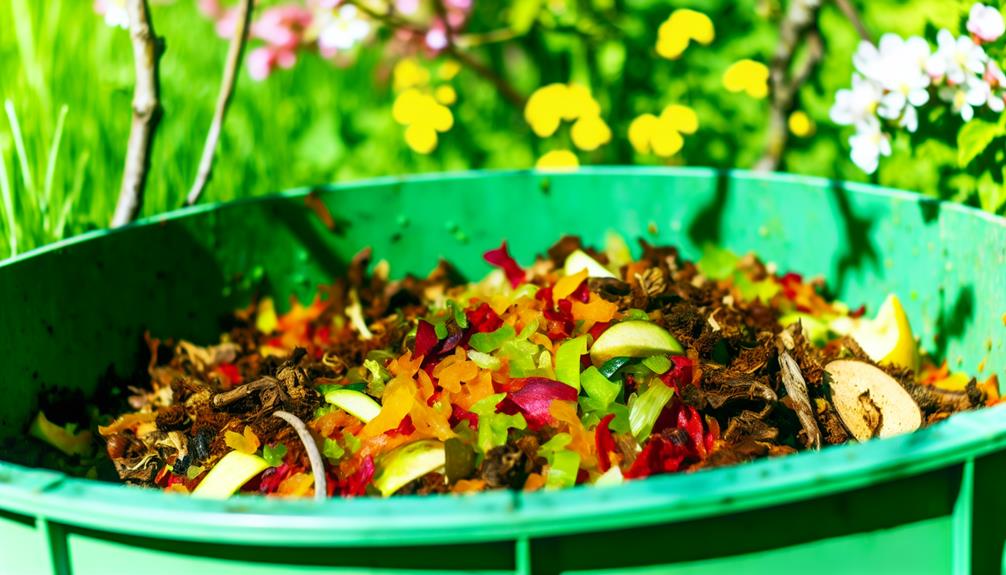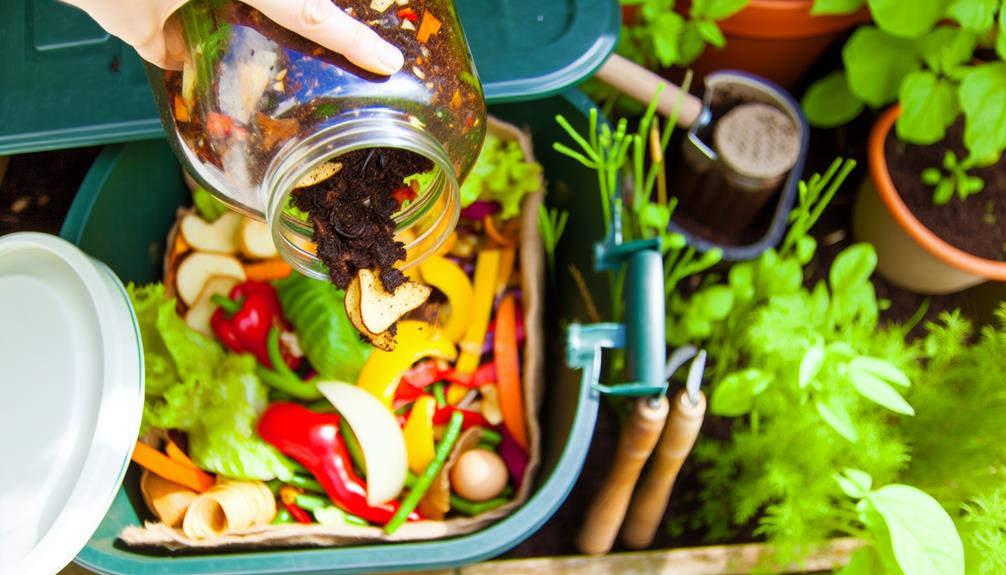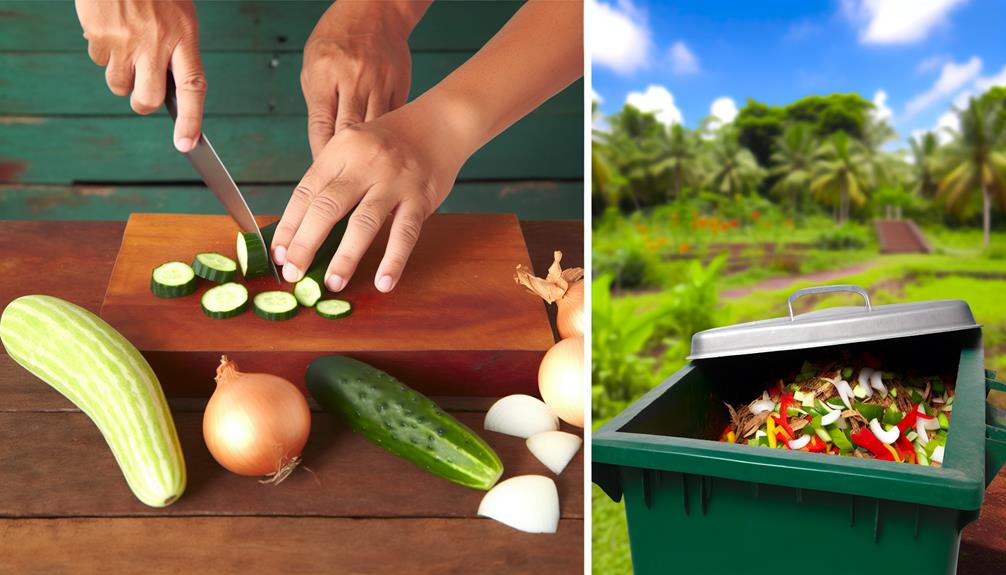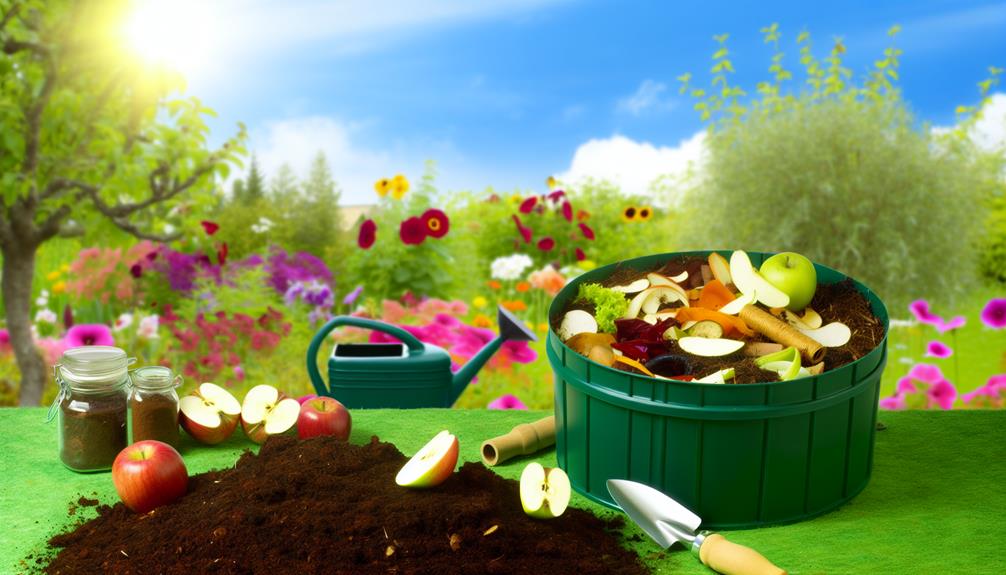

Yes, you can compost relish, but you’ll need to prepare it properly. Start by draining any excess liquid to avoid too much moisture in your compost. Since relish contains vinegar, balance it with green and brown materials to maintain a stable pH. Be mindful of the sugar and salt content as these can attract pests and disrupt the microbial balance.
To mitigate these issues, mix relish with carbon-rich materials like leaves or cardboard. By following these steps, you can enrich your compost and reduce kitchen waste. Want to guarantee ideal composting conditions and avoid common pitfalls?
Relish is a condiment made from chopped vegetables, fruits, spices, and vinegar that adds a burst of flavor to your meals. It’s more than just a tasty addition, though; relish has deep cultural significance and rich historical origins.
Understanding relish’s background can enhance your appreciation for this versatile condiment. Relish’s historical origins date back centuries, with different cultures contributing their unique twists. Ancient civilizations used preserved vegetables and fruits to extend their shelf life, resulting in early forms of relish. This practice wasn’t only practical but also a way to infuse meals with diverse flavors.
Over time, these methods evolved, and various regions developed their own distinct types of relish. Cultural significance plays a major role in the identity of relish. For instance, in the United States, relish is a staple at barbecues and picnics, symbolizing community and togetherness. In India, relishes like chutneys have long been integral parts of meals, adding both flavor and a sense of tradition.
Also Read: Can You Compost Ice Cream?
To truly appreciate the cultural and historical significance of relish, it’s important to know the key ingredients that make it so flavorful and versatile. Relish, as a condiment, boasts a rich blend of ingredients that highlight its diverse pickle varieties and unique condiment origins.
Typically, relish includes:
Understanding these ingredients helps you appreciate why relish has been a beloved addition to meals across cultures.
Whether you’re making a classic dill pickle relish or experimenting with more complex flavors, knowing the basics of its pickle varieties and condiment origins will help you create delicious, homemade versions.
Also Read: Can You Compost Mail?
Composting is an eco-friendly way to recycle organic waste into nutrient-rich soil. When you compost, you’re participating in a natural process that reduces waste and benefits the environment. There are several composting methods to contemplate, each with its own set of advantages.

Two popular methods include aerobic composting, which requires turning the pile to introduce oxygen, and anaerobic composting, which doesn’t require turning but takes longer to break down materials.
To get started, you’ll need a compost bin. Compost bins come in various shapes and sizes, from simple DIY setups to commercially available models. Choose one that fits your space and needs. Place your compost bin in a well-drained area with good air circulation.
It’s important to balance green materials, like fruit scraps and vegetable peels, with brown materials, such as leaves and paper. This balance helps maintain the right moisture and nutrient levels. As you add materials to your compost bin, chop larger items into smaller pieces to speed up decomposition.
Regularly turning your compost helps aerate the pile and speeds up the breakdown process. By following these basic composting methods, you’ll create valuable compost for your garden.
You might be wondering if you can compost that leftover relish from your last barbecue. The short answer is yes, but let’s explore the details. Relish, with its rich history origins and diverse culinary uses, can indeed be composted, but there are certain considerations to keep in mind to make sure your compost heap remains healthy.
Relish typically consists of chopped vegetables, vinegar, and spices. When adding it to your compost, you should:
Understanding the history origins and culinary uses of relish helps you appreciate its composition. Relish has roots in various cultures, often used to enhance flavors in meals. By composting it, you not only reduce waste but also contribute to a sustainable lifestyle.
Also Read: Can You Compost Rust?
When you compost relish, you enrich your soil naturally, creating a nutrient-rich environment for your plants.
This simple practice also reduces kitchen waste, turning potential garbage into valuable compost material.
Additionally, using composted relish promotes healthier plant growth by improving soil structure and fertility.
Relish scraps break down into nutrient-rich compost, enhancing soil fertility and promoting healthier plant growth. When you compost relish, you’re introducing a variety of nutrients back into the soil. This process invigorates soil microorganisms, which play an essential role in nutrient cycles. These tiny organisms help break down organic matter, releasing essential nutrients that plants need to thrive.
Boosts nutrient content: The decomposition of relish adds important nutrients like nitrogen, phosphorus, and potassium to the soil.
Improves soil structure: Organic matter from compost enhances soil texture and helps retain moisture.
Encourages biodiversity: A rich compost environment supports a diverse range of soil organisms, contributing to a healthier ecosystem.
Composting relish not only enriches your soil but also greatly reduces kitchen waste. When you choose to compost your leftover relish, you’re actively participating in waste reduction, which is a cornerstone of sustainable living.
Instead of tossing that jar of expired relish into the trash, where it would contribute to landfill mass, you can turn it into valuable compost material. This process helps you cut down on the amount of waste your household produces.
First, gather your relish and any other compostable kitchen scraps. Combine them in a compost bin or pile, ensuring a good mix of green and brown materials. Green materials include your relish, vegetable peelings, and fruit scraps, while brown materials consist of items like dried leaves and cardboard. This balance is essential for effective composting.
Transforming your leftover relish into compost provides essential nutrients that promote healthy plant growth. By doing this, you’re not only reducing kitchen waste but also giving your plants a crucial nutrient-rich boost.
Relish, with its unique flavor profile and diverse condiment history, breaks down into valuable organic matter that enriches the soil. This process helps your garden flourish in several ways.
Also Read: Can You Compost Rust?
When composting relish, you’ll encounter some challenges. The high salt content can disrupt the balance of your compost, and it also tends to attract pests.
Knowing these drawbacks helps you manage your compost more effectively.
The high salt content in relish can hinder the composting process by disrupting the microbial balance needed for decomposition. Salts are commonly used in food preservation, especially in condiments like relish, which has a rich history of enhancing our meals. However, this very trait poses challenges when it comes to composting.
Here’s how high salt content affects your compost pile:
To make sure your compost thrives, you’ll want to be mindful of what you add. While relish is a beloved part of condiment history, its salt content is something to take seriously. If you must compost relish, dilute it with low-salt organic matter or avoid it altogether. This way, you maintain a healthy, balanced compost pile.
Due to its strong scent and sugar content, relish can easily attract pests to your compost pile. This can be a major issue when trying to maintain a healthy and balanced compost. Pests such as rodents, insects, and even raccoons might be drawn to the sweet aroma, causing disruptions and potentially spreading disease.
To manage this, you need to implement effective pest control measures. Understanding the types of pests that relish can attract and how to deter them is essential. Here’s a quick reference table to help with pest deterrence:
| Pest | Why Attracted | Deterrence Tips |
|---|---|---|
| Rodents | Sweet smell, easy food | Bury relish deep, use a closed bin |
| Insects | Sugars, strong scent | Balance compost with dry materials |
| Raccoons | Strong aroma, food source | Secure compost with a lid, use repellents |
| Flies | Sugars, organic matter | Cover with soil or leaves |
| Ants | Sugars | Use diatomaceous earth around pile |
Also Read: Can You Compost Carrot Peel?
Before adding relish to your compost, make sure to remove any non-organic materials like plastic and metal. This is especially important if you’re dealing with store-bought relish, as it often comes in containers with labels and other packaging materials.

Homemade recipes, on the other hand, typically involve fewer non-organic elements, making them a bit easier to prepare for composting.
Here’s how you can prepare relish for compost:
Occasionally, you might need to explore alternative disposal methods for relish if composting isn’t an option. First, consider pickle disposal through your municipal waste system. Many cities offer organic waste bins where you can dispose of food scraps, including leftover relish. Check your local guidelines to see if this option is available to you.
Another method is to repurpose the leftover relish. You could use it as an ingredient in recipes like potato salad or as a topping for grilled meats. This not only reduces waste but also adds flavor to your dishes.
If neither of these options works, you might consider donating the leftover relish. Local community kitchens, food banks, or shelters often accept unopened, non-perishable food items, and relish could be a welcome addition.
Lastly, if the relish is no longer edible, you can dispose of it in your regular trash. Although this isn’t ideal, it’s a practical solution when other methods aren’t feasible. Remember to seal the relish in a biodegradable bag to minimize environmental impact.
Also Read: Can You Compost Cardboard Tubes?
Experts agree that mastering the art of composting relish can greatly enhance your composting efforts and benefit your garden.

To achieve the best results, consider these expert tips. First, understand that relish, with its various flavor variations, can be a rich addition to your compost pile. However, you need to balance it correctly with other compost materials.
Understanding the historical origins of relish, often made from pickled vegetables, helps you realize its potential composting value. These vegetables decompose well, providing essential nutrients.
Follow these tips, and you’ll be on your way to a thriving compost system, connecting with fellow composting enthusiasts who share your passion for sustainability and gardening.
Yes, composting relish can attract pests. To guarantee pest prevention and rodent deterrence, you should bury the relish deep in the compost pile and cover it with dry materials. This keeps your compost community-friendly and tidy.
Relish’s decomposition time depends on your compost’s heat. In a well-maintained, hot compost pile, it could take a few months. If your compost is cooler, expect it to take longer. Keep your community compost thriving!
When composting relish, avoid varieties with high preservative content and artificial coloring. They can harm your compost’s natural balance. Stick to organic or homemade relish for the best results and to keep your composting community thriving.
Relish compost can affect the pH level of soil. It helps in soil enrichment and maintains a healthy microbial balance. By composting, you contribute to a thriving community garden, enhancing everyone’s growing experience.
Yes, it’s safe to compost relish with other food scraps! Just make sure it’s free of preservatives. You’ll enhance food safety and enjoy the compost benefits, creating a richer, more vibrant garden that connects you with nature.
To conclude, you can compost relish, but do so cautiously. Make sure it’s free from excessive oils and salt, and balance it with carbon-rich materials like leaves or paper. This helps maintain a healthy compost.
If unsure, consider other disposal methods such as feeding it to animals or using it in the garden as a direct soil amendment. Always monitor your compost for any adverse effects.
Following these guidelines will help you compost relish effectively and sustainably.
